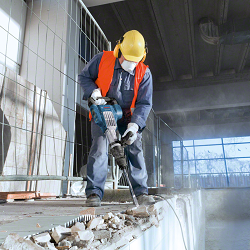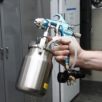Choosing a niler for nails
Construction work is constantly accompanied by the need to connect various structures or their individual elements together, for example, installation of formwork and roofing materials, flooring. Traditionally, a hammer is used for these purposes, with which nails of various shapes are hammered. But gradually it is being supplanted by various types of neulers. This modern tool helps to perform a large range of repair and construction work much faster than using a conventional hammer. Despite the relative novelty of these products, the market is filled with devices from different manufacturers and various systems of operation. Even there are products designed to perform only certain operations.
Content
Niler application
The nailer of any system is a nail gun. In the popular environment, this tool is also called:
- nail gun;
- nailer;
- mounting gun;
- nail art;
- pneumatic hammer;
- electric hammer.
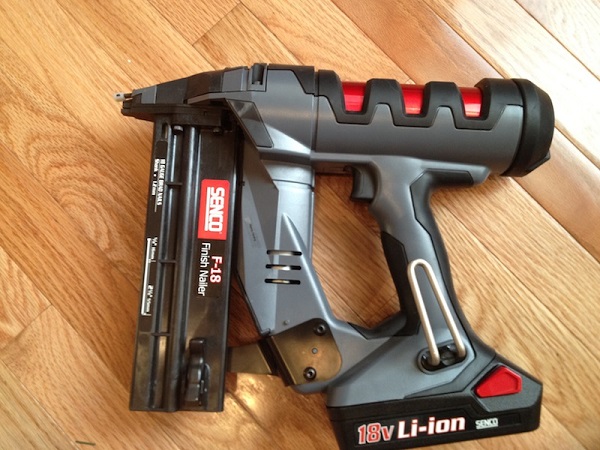
The last two names refer to the device types: pneumatic and electric.
Nailing gun consists of the following parts:
- body with a handle (it has a trigger);
- piston;
- store designed for nails.
The main purpose of the nailer is to assembly of various designs and installation of various communication (engineering) systems. By means of the assembly gun perform the following operations:
- fix the warming materials;
- fix communication lines (for example, cable, pipes);
- collect formwork structures (shields);
- make stairs;
- fix guides of tension and suspensions of gypsum ceilings;
- collect door and window boxes, and also fix them in the corresponding apertures;
- make packaging (boxes), pallets and pallets;

- establish hedges (fences);
- attach the mesh to the plastered surfaces;
- make different furniture, sheathing it after a soft material;
- attach carpets;
- mount wall panels;
- make a covering of frameworks various materials: plywood, OSB, lining, plasterboard sheets, siding, chipboard and other;
- install slings using perforated corners;
- attach the console brackets;
- build houses of frame type of sawn timber;
- nail plinths (plastic, wooden), beadings, slats, molding;
- lay floors (wooden draft, fair, parquet);
- mount the roof of the boards and its cover (profile sheets, metal, roll materials, bitumen and ordinary tiles).
This list is not limited to the scope of the nomers. In addition to nails, the tool can be equipped with studs or pins to carry out finishing repair. In high-power models, steel dowels are used, intended for driving, without carrying out preliminary drilling work, into concrete,metal (steel), brick, and the surface of other hard materials.
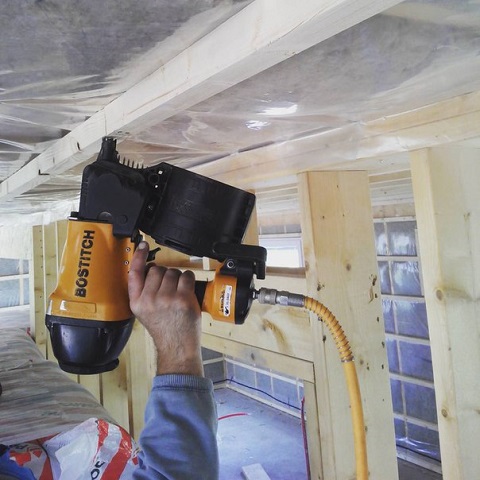
Operating principle The tool is based on the fact that under the influence of the energy of gunpowder, electricity, gas, compressed air or mechanical piston is set in motion. He hits the head of the nail, driving it into the material of the working surface. After the stroke is completed, the piston becomes its original position, and a new fastener comes from the magazine. The device is turned on by pressing the trigger or touching its nose to the working surface.
The use of the nailer allows in practice to increase productivity by about 3 times, to reduce the number of scrap on the surfaces of the workpieces (chips, chipping, dents).
Neiler Classification
Mounting guns are divided into separate groups according to the following criteria:
- according to the type of magazine installed for fasteners;
- by area of use;
- on the energy source that drives the piston.
According to the first criterion, the devices are divided into 2 types:
- cassette, in which the nails with plastic or paper are connected in a straight (rail form) clip;
- drum, where fasteners fastened together with wire, wound in the form of a roll.
Disadvantage cassette stores is their small capacity: up to hundreds of pieces in one holder. Drums however, they accommodate a large number of nails, providing the possibility of prolonged work operations without recharging. But at the same time, the weight of the neural increases significantly compared with the rack option.
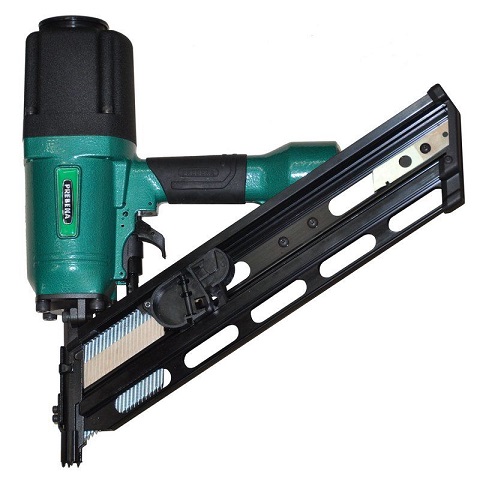
Cassette type
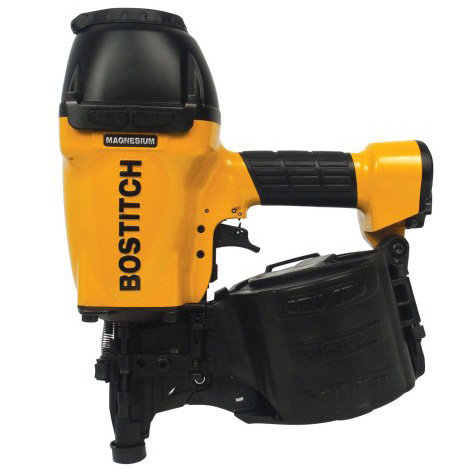
Drum type
The classification division of the installation guns according to their scope (purpose) is conditional. This is due to the fact that there is no clear way to correlate individual models with any category. But the division into groups according to this criterion allows you to determine the types of work performed, which contributes to the correct choice of tool.
Nail Guns as a drive system are:
- mechanical;
- pneumatic;
- electric;
- powder;
- gas;
- combined.
Each of the types of instrument according to the source of energy used is characterized by the characteristics of its work, which determine the advantages and disadvantages of devices.
Mechanical tool
Staplers are a mechanical variety of nailers. The operation of such devices is based on the use of spring energycompressed. The mechanism is activated by pressing the trigger located on the handle.
Most models of staplers are used for driving staples, but there are also modifications of the combined type, where it is also possible to use nails.
Using mechanical pistols pull furniture, work with non-solid materials, for example, OSB, particle board, fiberboard, plywood. They are also suitable for lining of soft wood.
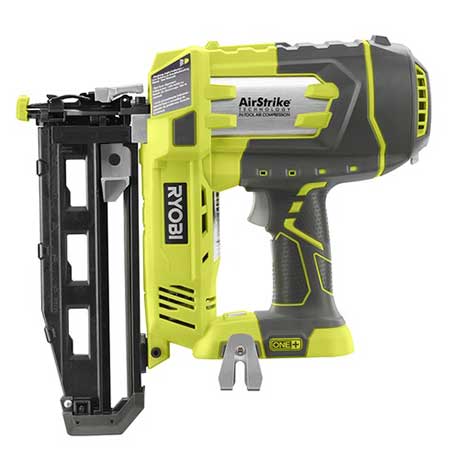
Electromechanical neyler Ryobi P325
Benefits staplers have the following:
- low cost;
- security;
- compact size;
- a light weight;
- simple design, allowing self-repair product;
- ease of use.
Among the shortcomings distinguish only low power mechanical devices in comparison with other analogues. Taking into account the ratio of price and functionality, staplers are the most affordable, easy-to-use tool for carrying out simple fastening operations.
Pneumatic devices
Pneumatic neiler is The most common in practice, the type of nailers. They are represented by a large variety of modifications in size and purpose: from working with studs (finishing) to a tool of considerable size, allowing you to hammer large nails (220 mm long and 5 mm thick), for example, Haubold RN 220R.
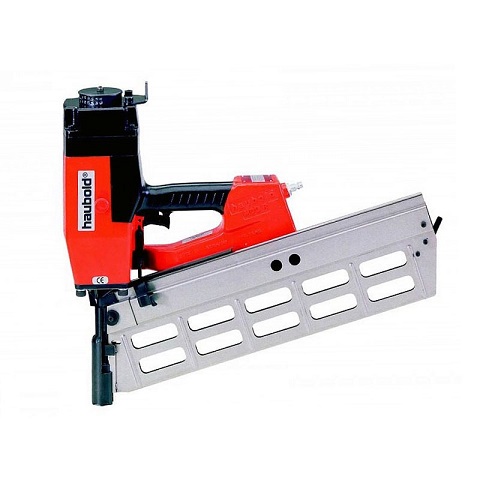
Pneumatic nailing gun Haubold RN 220R
Pneumatic tools use compressed air to do work. For this reason, for him necessarily compressor needed. But this is not a problem, because many models operate in a pressure range of 4-8 bar. This value corresponds to the technical parameters of an inexpensive compressor unit. Manufacturers of pneumatic guns usually lead to requirements for the level of performance of the compressor unit, the consumption of 1 shot of air, as well as the volume of the receiver. Instead of compressor units, cylinders containing compressed air are also used.
To protect against shots into the void, the pneumatic equipment is equipped with a special mechanism: it works only after pressing to the surface of the material.
On the market there are powerful models that are almost comparable to the gas and powder varieties. They operate at a high pressure of 18-30 bar. An example would be the machines of the Japanese company MAX Co.Ltd. HN25C or HN120.
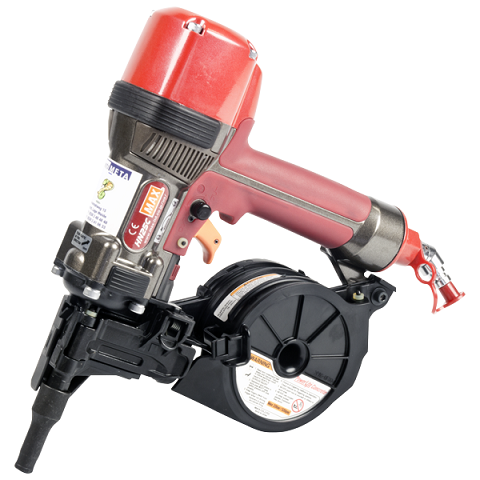
Pneumatic mounting gun MAX HN25C
TO pluses pneumatic devices include:
- large amount of power, providing the impact force up to 100 J;
- reasonable price (starting with hundreds of dollars);
- small recoil force;
- the ability to perform up to 3 shots within a second (firing rate);
- low outgoing noise;
- operation is possible at high humidity, in an explosive environment, in a confined space (closed);
- ease of operation and maintenance;
- low weight (average weight is 1-3 kg) and compact dimensions;
- relative simplicity and greater reliability of products;
- low cost per shot.
The positive thing is that to work with pneumatic tools no need to get permissionsas for powder analogs.
There are no particular drawbacks to pneumatic nailers, but some inconveniences are caused by the fact that the compressor units operate from a stationary 220 V electrical network.A number of manufacturers install battery packs to solve this issue, for example, TRUSTY TBC-3214 works without recharging for about half an hour.
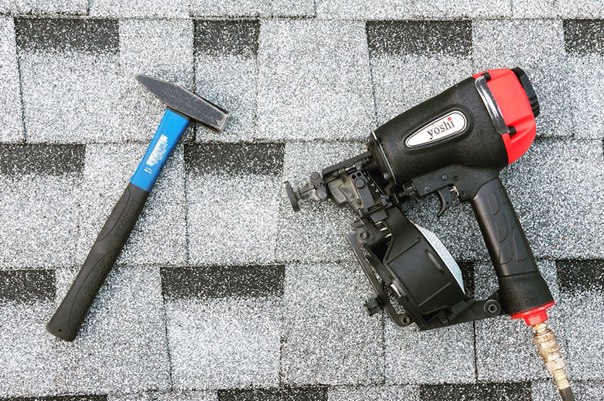
Neiler connects to the compressor using a hosethat withstands high pressure - this to some extent limits the freedom of movement of the worker. But modern air ducts weigh little, possessing in addition a high degree of elasticity. Conducting working manipulations also facilitates a long hose length.
Gas mounting guns
A gas nailer is a mobile tool that uses energy from explosive mixture. The product resembles an internal combustion engine. The principle of its operation is as follows:
- from the cartridge in the working chamber enters the gas, which is easily flammable;
- there it is mixed with a fan with atmospheric air;
- then the spark from a candle powered by a battery built into the device ignites the mixture;
- the force of the explosion is transmitted to the piston hitting the nail.
The power of gas pistols is large, so you can use dowels for concrete or metal in them, making direct installation.
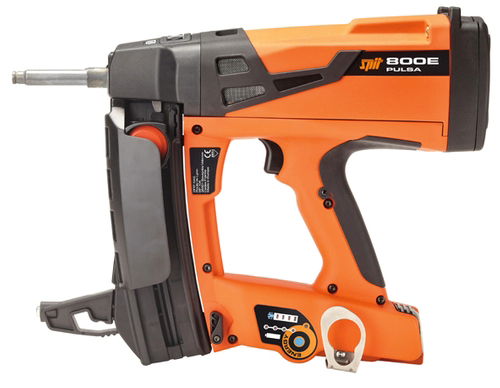
Gas mounting gun Spit Pulsa 800E
Gas cartridges The naylera are usually sold in a package with nails, which allows you to calculate the cost of a single shot. Consumption is determined by the purpose of the equipment model used, as well as partly by the material with which it is necessary to perform working operations. On average, the gas supply and battery capacity is enough to hold more than 1000 shots.
For gas guns are characterized by such advantages:
- permission to use is not necessary;
- the big power allowing to carry out installation without preparation on steel, a brick, concrete, a solid tree;
- high autonomy;
- lack of additional hoses and cords (ergonomics);
- moderate weight, amounting on average from 2.5 to 4 kg;
- ease of maintenance;
- ease of use.
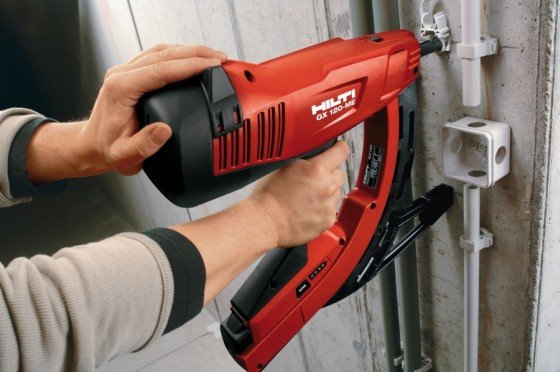
Gas mounting gun Hilti GX 120
TO disadvantages gas powered gas neulers include:
- the need for regular cleaning of the combustion chamber;
- new models cost up to a thousand dollars;
- constantly required to consider the level of battery charge;
- big sizes in comparison with mechanical and pneumatic analogs;
- relatively high cost per shot;
- exhaust emissions during operation.
When working with gas pistols, you should regularly ventilate the room to get rid of the exhaust.
Powder nailers
Powder nails are designed for direct installation of dowels in the surface of solid materials. By the principle of operation, the tool is similar to a firearm type weapon: shock energy arises after an explosion of a charge in a cartridge. The power of the shot directly depends on its power. It is also affected by the adjustment of exhaust gases. Cartridges are of different caliber and power (its value is marked with a certain color).
Powder guns can operate in 2 modes:
- automatic (cassette filing of cartridges - up to 1000 per hour);
- semi-automatic (cassette-disk feed)
Some modifications can work in single shot mode with nails over 90 mm long.
Before you start using the tool, you must run preliminary adjustmentand also study the density of the base material. Due to the design, through-shot are excluded.For the device to work, it must be pressed tightly against the surface of the base, and then release the fuse.
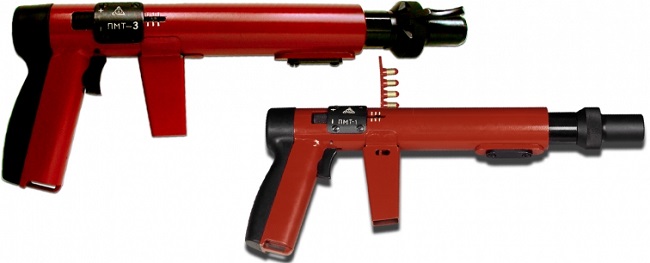
Powder nylon PMT-1 and PMT-3
Gas guns are charged with dowels for concrete, for metal, with threads, with wide caps and others. The choice of fasteners is determined by the characteristics of the base material.
The pros powder neilers are:
- significant force of a shot (300 ÷ 550 J);
- autonomy;
- small weight, compactness;
- wide selection of nails;
- strong grip.
Also attached to products a number of minuses:
- only suitable for direct installation work;
- relatively difficult to operate, because you need to pick up the cartridges for the power level, the corresponding dowel, set the pressing force and so on;
- exhaust emissions;
- must not be used in flammable or explosive rooms;
- it is necessary to regularly clean, replace parts that wear out quickly;
- financial costs of the shots;
- hold the tool requires two hands;
- for the work necessary to obtain special permits.
Electric naylery
Electric neyler power almost comparable with mechanical devices. Its operation is based on pulse energy. Manufacturers produce network and battery models. They are mainly intended for finishing finishing works, because they use small-sized consumables (pins, studs). Using an electric nailer, you can drive a nail up to 6.5 cm long.
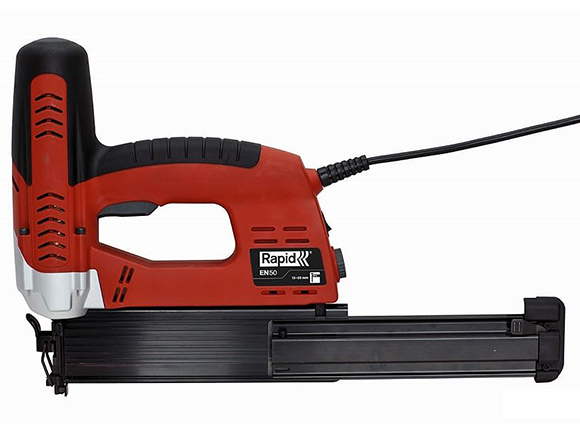
Battery neiler - This is a mobile version of the equipment, in practice, well-proven. Operational characteristics are close to the network analogues. So, the GSK 18 V-LI Professional model from Bosch has an 18 volt battery, which can produce about 700 shots on one charge. The size of nails used ranges from 32 to 63 mm.
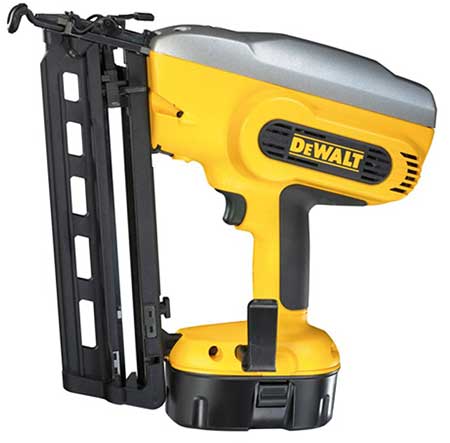
Electric accumulator neyler DeWALT-DC618KB
Merits electric mounting guns:
- ease of use;
- maintenance is kept to a minimum;
- no exhaust;
- insignificant level of vibrations, noise;
- battery nailer allows you to work independently;
- network models differ in small weight and dimensions;
- shots are cheap.
disadvantages Electric nailing devices are as follows:
- small shot strength;
- attachment of network models to power sources;
- must not be used in explosive or damp rooms;
- relatively high price of products;
- low speed shots (1 per second).
Combined nailers models
Senco Fusion Pistol is a combination nailer. It implements special technological solutions. The pneumatic cylinder is the main unit of this device. It contains compressed nitrogen, forcing the piston to move forward. Its returnable movement is provided by an electric motor that is powered by a battery pack. The system is a closed loop. At the same time periodically recharge the battery. It lasts for about 500 shots.

The combined modification has a whole a series of positive points:
- rate of fire is at a high level (in a second - 3 shots);
- no exhaust;
- cheap shots;
- autonomy and ease of use;
- power is comparable to mid-range pneumatic equipment.
Also have minor cons:
- it is necessary to monitor the level of battery charge;
- relatively high cost (about 60,000 rubles).
Types of neulers to destination
Often, manufacturers are positioning their products as a tool for individual work operations. This is due to the limited size of consumables.
The boundaries between individual groups of devices are destroyed due to the possibility of using adaptive attachments on some models, which allow to use different types of fasteners in practice.
According to the classification of the intended purpose of the tool is the following types.
- Framedesigned for the assembly of draft structures (for example, for floors, crates), because of which nails of 50-220 mm are used in the work. The frame Nayler is equipped with consumables with D-shaped or round caps, which are packed in a drum or rail. In addition, each model is designed only for working with nails of a certain length (for example, 90-120, 50-90). This is due to the power of the units and is determined by the size of the drums or cassettes.
- Platingworking with nails from 25 to 75 mm (with sufficiently wide caps up to 7.5 mm in size). Plating guns are used to attach sheets of different materials to wood frames.The consumption of nails is big, so they are fed by drums.
- Finishing (finishing), used when fixing shtapik, plinths, moldings, exterior decor, platbands with the help of studs with pins. In individual modifications of finishing pistols, the impact parts are equipped with rubber elements that protect the parts from deformations.
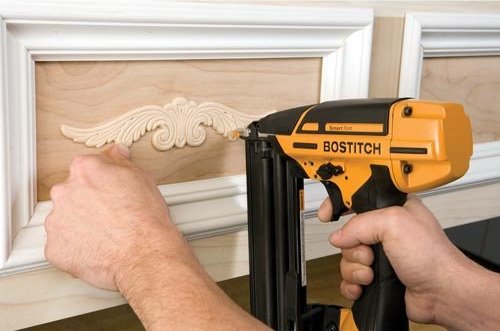
Finishing Nayler 18GA BOSTITCH BTFP12233 Smart Point
- Roofingused when installing roofing felt on roofs, bitumen and profile tiles, equipped with a galvanized consumable of a special design with a cap of approximately 10 cm in diameter. Nails of 25-50 mm are used for non-rigid roofing. Roofing guns are similar to cladding analogues.
- For attaching punched elements. The tool differs from the frame analogs by the presence of a special device that helps to get into the holes without much effort.
- For drywall work. Equipped with special consumables (brushed, twisted) with a large cap length of 30-50 mm.
- Parquetwhere are used studs or nails in the form of the letter G.
- For direct installation work for metal, concrete, wood, brick, with various dowels-nails being used as consumables.
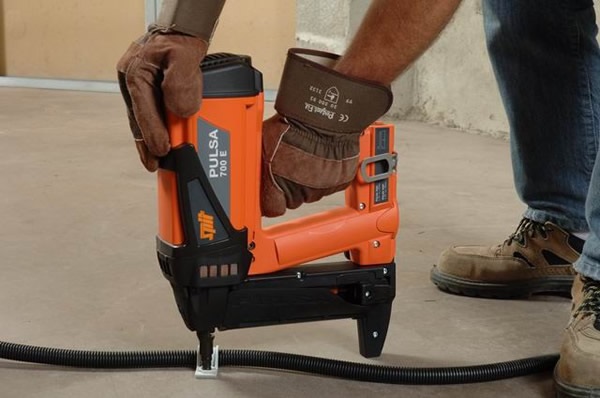
There are also models designed for fixing insulation. They have a puck that allows them to penetrate the surface of the material without tearing it. Adapters of this kind can be equipped with different nailers.
To work comfortably in uncomfortable, hard to reach places, apply palm patterns pneumatic type. They can be charged individually by nails of different sizes. For this reason, they are considered almost universal.
The main characteristics for the choice of the nailer
Before you buy a mounting gun, the question arises about his choice. We have to be determined among the many models of different systems from different manufacturers. To make a purchase, you need to consider:
- work surface material;
- tool drive system (determines the cost of a shot);
- upcoming volumes and nature of work (for example, finishing, with insulation, roofing);
- Type of suitable fasteners.
It should be borne in mind that only powder and gas neilers will cope with metal and concrete. With the help of mechanical and electrical models, it will be possible to hammer fasteners into the surface of soft materials: wood, plastic, plywood, drywall, chipboard and others. Air guns can drive nails into the concrete of some brands.
If you have to work with the tool very much, then you should choose powerful (professional) models, and weaker (household) modifications will be suitable for one-time operations.. So for home operation enough pneumatic tools with a working pressure of 5-7 bar. In professional devices, its value will be at least 18 bar.
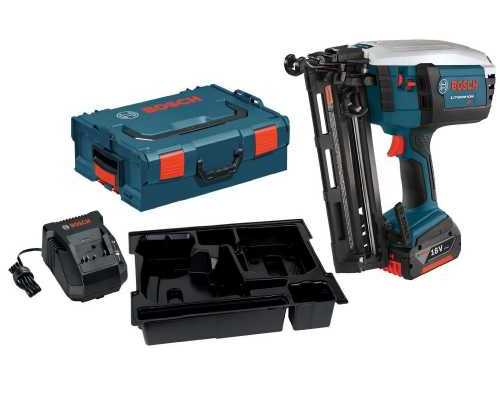
Mounting gun neyler Bosch GSK 18 V-LI Professional (FNH180KL-16)
Each nailer model can only work with fixture of a certain size. This partly affects the spectrum of operations performed with it. When it is necessary, for example, to overlap the roof, you need a nail for a tile. You can pick up the device for the intended purpose, using the previously given classification.
In addition to the cost of the tool itself, you should also consider single shot price. It may be that the practical use of pistols will be accompanied by a large monetary cost of consumables, when the material of the surface allows you to get by with a cheaper option.
When choosing a mounting gun, you should also take into account the following technical characteristics and additional functionality:
- the number of beats per minute and their strength;
- configuration features;
- is there a double blow;
- availability of a convenient case for transportation;
- the ability to control the force of impact.
If you plan to use the nailer in different directions, it is recommended to consider the ability to adjust the depth of the drive fasteners.
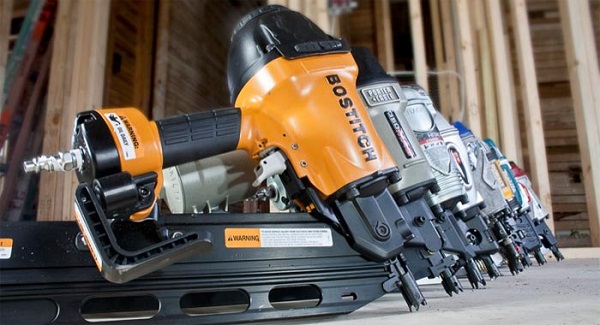
High accuracy of work performance will be provided by models capable of performing single blow. If the volumes are large, then you should apply modifications with reels, working in bursts.
It is good when the device being operated is switched on in combination (by a hammer and a spout), and on it it is possible to switch the operating modes: from single to serial.
A brief overview of the manufacturers of neiler
Nailing guns are produced by many firms engaged in the manufacture of building fixtures and tools. Very often found on the market products of such manufacturers:
- Bosch;
- Sumake;
- PULSA;
- HILTI;
- Dynamik;
- Fubag;
- DeWalt;
- Haubold;
- Makita;
- Matrix;
- TRUSTY;
- Bostitch and others.
Manufacturers are constantly expanding the range of products and improving products. So, MAX manufactures a nailer that combines screwdriver functions. In this case, the fastener is simultaneously driven in and screwed into the surfaces of various materials, including metal.
In stores, mounting guns are divided by price categories. Budget options from well-known manufacturers is enough for home use. When choosing a tool, first of all, they take into account the type of upcoming work, on which the required dimensions of fasteners depend. Also, the acquired nailer must have a system of protection against accidental activation and from shots into the air to ensure maximum safety when handling.

/rating_off.png)







